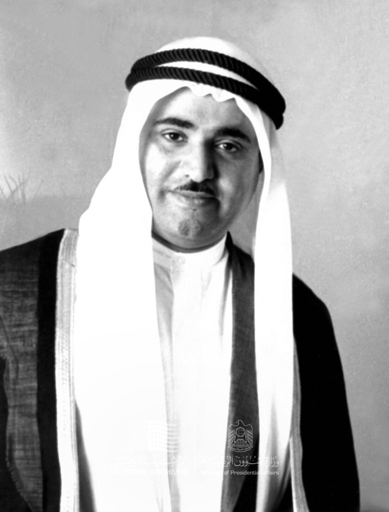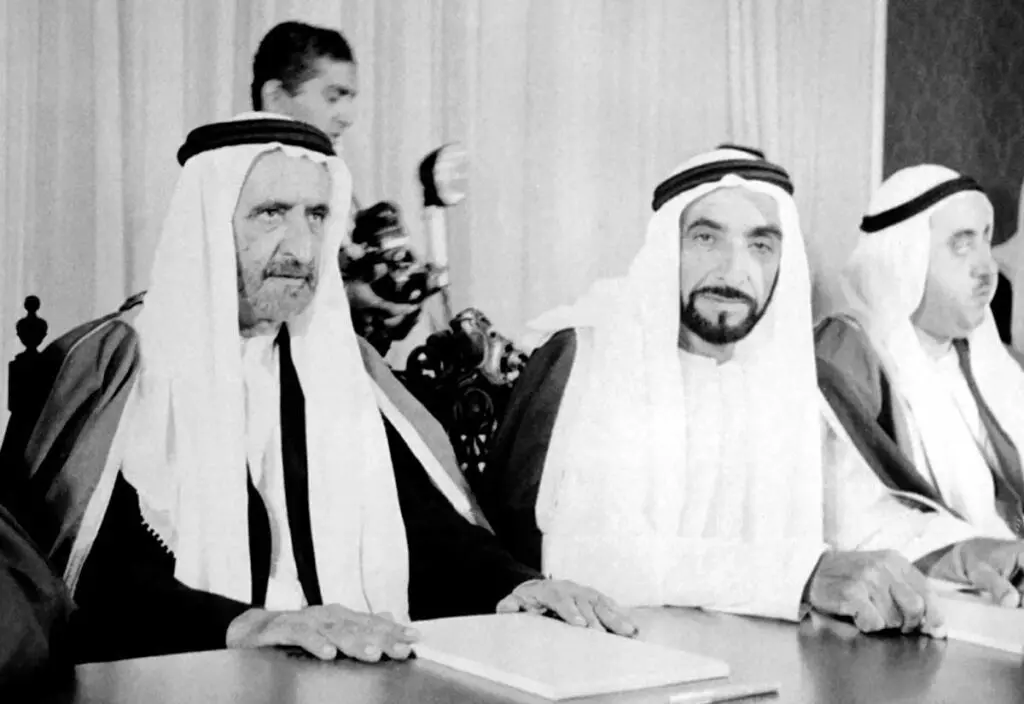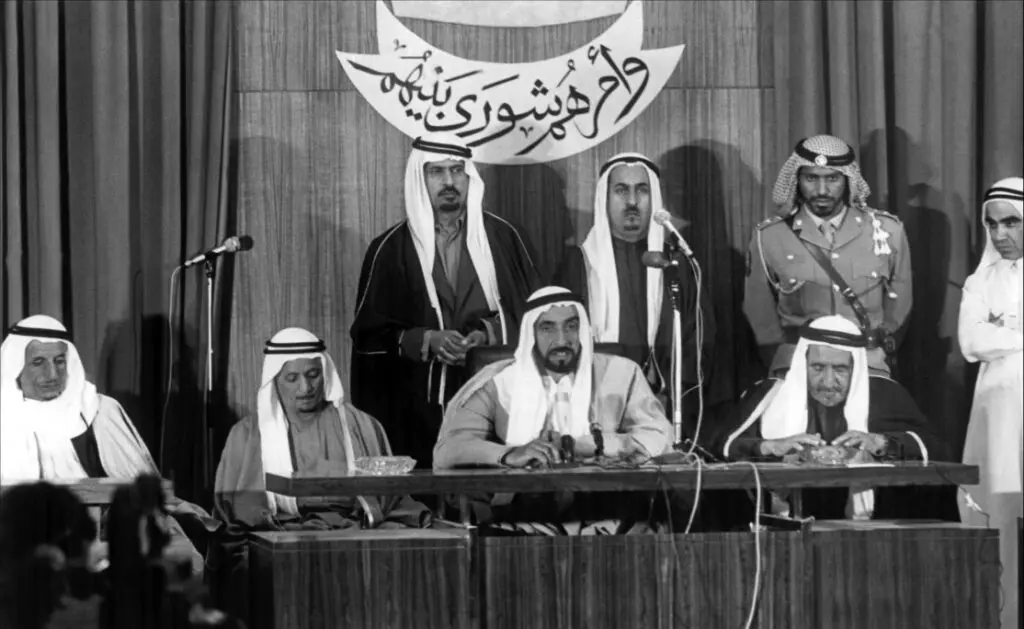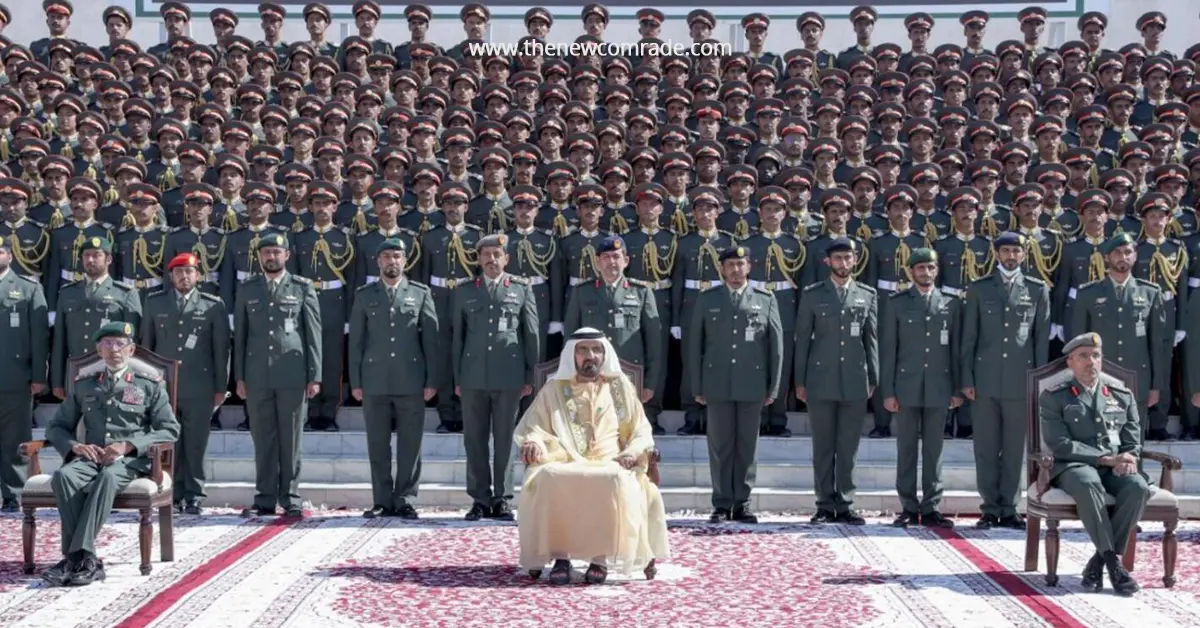Zayed as President
Abu Dhabi’s ruler Zayed bin Sultan Al-Nahyan was chosen as the new president for a five-year term and Rashid bin Saeed Al-Maktoum, ruler of Dubai, as Vice President. Each emirate continued to retain its own military forces, sovereignty over its internal affairs, and ownership of wealth and natural resources from its territory. UAE did not initially have a large foreign diplomatic presence. When its establishment was announced, it only had three foreign embassies on its soil, belonging to Britain, Pakistan, and US.
Initial challenges
Union’s establishment and progress were not smooth. Internal disputes eventually escalated into armed clashes, such as those between Sharjah and Fujairah in 1972 and 1974 over the demarcation of their borders and status of Dibba area. Similarly, between Fujairah and Ras Al-Khaimah over Masafī. Border disputes between Dubai and Sharjah in 1976 even necessitated international arbitration.

(Photo credit: www.nla.ae)
The most serious practical challenge faced by the Union was in January 1972, when the deposed ruler of Sharjah, Saqr bin Sultan Al-Qāsemī (deposed by Britain, as previously mentioned) stormed into the office of the Emir of Sharjah, Khālid bin Mohammed Al-Qāsemī ,and forced him to abdicate. This was followed by clashes in which Sultan, the brother of the Emir of Sharjah, sought aid of Union forces. These clashes resulted in the death of Khālid Al-Qāsemī, and capture of Saqr, thus thwarting his attempt to regain power. Sultan bin Mohammed Al-Qāsemī, brother of the slain ruler, was appointed as the new ruler of Sharjah. But investigations found that the coup attempt was supported by the ruler of Ras Al-Khaimah, Saqr bin Mohammed Al-Qāsemī, in order to separate Sharjah from the Union and form, with Ras Al-Khaimah, another union. Failure of that scheme precipitated Ras Al-Khaimah’s rush to join UAE in February 1972. There had also been an attempt in 1987 to oust Sultan bin Mohammed by his elder brother Abdulaziz bin Mohammed, who had been Crown Prince under Khālid bin Mohammed and was passed on in 1972.
Similarly, there were frequent disagreements between the rulers of Abu Dhabi and Dubai, Zayed bin Sultan and Rashid bin Saeed, respectively, because each sought greater influence in the nascent state affairs. Among the most prominent disagreements that occurred between them are:
1. Dispute over extension of interim constitution in 1976, where Sheikh Zayed wished to adopt a permanent constitution, strengthen the Union by means of a unified army, increase other emirates’ proportions of contribution to the federal budget; while Sheikh Rashid insisted on extension of interim constitution, which ensured independence of each emirate in most of their affairs in order to conserve wealth of Dubai, higher at the time, compared to the rest of emirates. Thus, in August 1976, Sheikh Zayed announced that he would step down as head of state by the end of his presidency’s term in December, though he rescinded the announcement after reaching a compromise that extended the interim constitution and made amendments that strengthened federalism.
2. In 1978, rulers of Dubai, Ras Al-Khaimah, and Umm Al-Quwain rejected Sheikh Zayed’s decision to merge the then-10,000-strong Abu Dhabi Defense Force with Union’s Defense Force. Furthermore, they rejected subsequent appointment by Sheikh Zayed of his son, Sultan, as Commander-in-chief of Union’s armed forces. Dubai’s ruler dismissed the decision as having been made unilaterally, without consulting the then-Minister of Defense Mohammed bin Rashid. The crisis ended with formation of a military council headed by the defense minister, the son of Dubai’s ruler and his deputy in the emirate, and as the Commander-in-chief, son of Abu Dhabi’s ruler.
3. In 1979, a war of communiqués between Dubai and Abu Dhabi erupted after Sheikh Zayed’s announcement that Dubai opposed integration of its institutions into the federal authority, which Sheikh Rashid responded to with a counter communiqué. The matter ended by appointing Sheikh Rashid as prime minister. Since then, it has been established that ruler of Abu Dhabi would serve as president of UAE, while ruler of Dubai would be prime minister.

Intensity of these disagreements between rulers of Abu Dhabi and Dubai diminished following Iranian revolution in 1979 and Khomeini’s commitment to exporting revolution abroad, as well as ensuing Iran – Iraq war in 1980 and Iraq’s invasion of Kuwait in 1990. UAE approved a permanent constitution in 1996.
Structure of Government
UAE is formally governed by a presidential system with president and vice president being chosen from among rulers of constituent emirates, who serve as members of the “Federal Supreme Council”, which is the supreme authority of the state. Supreme Council is responsible for drawing up domestic and foreign policies and ratifying federal laws before they are promulgated. Its decisions on substantive matters are determined by a five-person majority of its members, including votes of Abu Dhabi and Dubai. In procedural matters, decisions are made by a simple majority vote. Head of State presides over Federal Supreme Council, signs laws and decrees, and appoints diplomatic representatives to foreign countries. Federal government is granted specific powers as per the constitution, while governments of separate emirates have more extensive powers, with each emirate retaining control over its oil, mineral wealth, and internal security.
There is also an advisory “Federal National Council”, which in theory is supposed to discuss draft laws and budgets referred to it by the Federal Council of Ministers (cabinet). However, it does not exercise any oversight or legislative roles. The 40 members of this Council were appointed by the rulers of the constituent emirates with a specific slot for each emirate: eight seats for Abu Dhabi, eight for Dubai, six for Sharjah, six for Ras Al-Khaimah, four for Ajman, four for Fujairah, and four for Umm Al-Quwain. Since 2006, however, half of the Council’s members have been chosen through indirect elections – as a limited number of citizens are allowed to vote.

(Photo credit: www.thenationalnews.com)
It is worth mentioning that platforms of candidates for membership of the Federal National Council revolve around localization of jobs, empowerment of youth, development of education and health sectors, care for senior citizens, stimulation of investment and tourism—in other words, matters that do not address political issues.
UAE’s system of government is pragmatically contemplated as a compromise between authorities of different emirates in the hands of ruling families and those close to them, without allowing any serious participation of citizens in decision-making process and criminalizing any opposition to the State’s policies. Political parties are also prohibited. Anti-Terrorist Crimes Act of 2014 stipulates that anyone who publicly declares his disloyalty to State’s leaders shall be punished by imprisonment for a minimum of 10 years.
Influence of Mohammed bin Zayed
From inception until death of Zayed in 2004, UAE’s foreign policy had been characterized by pacifism and keenness, to invest relations for economic gains, and to identify only with the constants of Arabian Gulf orientations -especially Saudi Arabian ones- on issues of common interest. Such a policy was aimed at preserving the country’s newly acquired sovereignty and independence.
With the death of Sheikh Zayed and the assumption of power by Khalīfa bin Zayed Al-Nahyan, UAE gradually adopted a more aggressive foreign policy. This is partly due to the emergence of new ruling elites subscribing to realist school of foreign policy that considers the economy and the balance of power as the basic principles/pillars of foreign policy.
As the health of Zayed deteriorated, the most powerful figure in UAE landscape gradually became his son, Mohammed bin Zayed, then Second Crown Prince of Abu Dhabi, Chief of staff of UAE Armed Forces, and President of Mubādala Fund, one of the main investment instruments of Abu Dhabi government.
Area, Population, and Economy of the UAE and Reasons for the Domination of the Emirate of Abu Dhabi
UAE area is estimated at 83,600 square kilometers, of which 71,000 square kilometers are the mainland, while remaining area is occupied by over 200 islands. UAE ranks third in size amongst Arabian Gulf Cooperation Council (AGCC) countries, after Kingdom of Saudi Arabia and Sultanate of Oman. Desert covers nearly 74% of its territories, whereas mountains occupy 2.6%. Number of UAE residents multiplied in recent years, reaching 9.3 million residents by 2017.
According to many sources, UAE citizens number one million, or about 10.75% of the country’s population, while Indian citizens account for 38.2% and Egyptians 10.2%, according to 2015 statistics. UAE also ranks seventh globally in terms of oil and natural gas reserves. In 2017, the UAE’s cash reserves stood at US$95.37 billion.
UAE is also strategically located close to the Strait of Hormuz, through which approximately 18 million barrels of oil passes through daily; it represents lifeblood of many countries: It fulfils percent of 85% Japan’s oil needs, and 70% of India, China, and South Korea’s. The UAE is also a major global business hub; it hosts the regional headquarters for 25% of the largest 500 companies in the world. Further, UAE is a gateway to other AGCC states, where 61% of freight destined for AGCC states passes through its ports.
To, supposedly, reduce dependence on oil sales and provide a financial stock for future, UAE has in past two decades sought to channel its surplus oil revenues to engage in long-term foreign investments through several sovereign wealth funds (SWF), state-owned entities, or state-backed private companies. UAE’s foreign direct investment (FDI) has been growing rapidly since 2000, bringing total UAE investments abroad by 2015 to nearly US$63 billion, then to a staggering US$87.5 billion in 2017. Meanwhile, number of UAE companies investing abroad has exceeded 200 in more than 60 countries, and their assets range from US$1 trillion to US$1.5 trillion.
Externally, UAE has focused on investing in four key sectors: Aviation, urban construction, military technology, and agriculture. Such sectors reflect various strategic priorities. Agricultural investments are part of a strategy to mitigate risks related to food security, as the UAE imports 85% of its food supplies from abroad. Investments in the aviation and construction sectors are part of a strategic policy of economic diversification, in anticipation of much touted post-oil economy era.
By adopting economic diversification strategies, the UAE has increased the non-oil sectors’ contribution to the national economy, such as transformative industries, aviation, tourism, banking, trade, real estate, services, and alternative energy. This was reflected in the decline in oil’s contribution to gross national income from 79% in 1980 to 29.5% in 2017, which supported the country’s ability to contain fluctuation of oil prices and to expand military spending.
Reasons for Abu Dhabi’s domination
Abu Dhabi is, by far, largest emirate in terms of geographical area, representing 87% of total area, and richest, with 95% of oil reserves, 94% of gas reserves, and 9% and 5% of world’s oil and gas reserves, respectively. Abu Dhabi provides most of UAE’s oil production, which amounted to 3 million barrels per day in 2019, while the production of Dubai does not exceed 70 thousand parrels per day.
Founded in 1976, Abu Dhabi Investment Authority (ADIA) is now the fifth largest investment fund in the world after being the world’s largest one until 2009; its assets in 2019 are estimated at US$697 billion, according to the latest figures published by Sovereign Wealth Funds International (SWFI) foundation. Given that Abu Dhabi pays bulk of the federal budget, this allows it to dominate decisions on UAE foreign policy.
Emergence of Army
Trucial Emirates did not have their own armies throughout the first half of 20th century due to their dependence on British protection since 1892 and their inability, before oil discovery, to sustain costs of establishing military institutions. UAE army has its origins in the ‘Trucial Oman Levies’ (TOL), formed under British Royal Decree 1 of 1951. London wanted Trucial emirate rulers to view it as the tool of their protection and not seek to establish own extensive armies. Primary task of TOL was to maintain security outside large cities, protect British visiting delegations, and protect oil operations.

TOL initially consisted of a British commander, Major Hankin Turvin, and 35 Arab soldiers. It was renamed ‘Trucial Oman Scouts’ in 1956 in light of its increased size, which became five companies encompassing 150 British officers and soldiers and 500 Arab soldiers under the command of a British colonel. By 1964, TOL was made up of 1,201 Arabs (mostly from Oman, Trucial Emirates, Yemen, and Jordan) under the command of 38 British officers and 85 other British ranks, and a total of 1,324 men. The force was trained at RAF base in Sharjah and headquartered in Bahrain.
TOL did not enter cities without consent of emirate rulers. While larger cities, such as Dubai and Abu Dhabi, established own police forces in 1956 and 1957 respectively, security in other towns was provided until the late 1960s by emirs’ guards and tribesmen. Following commencement of oil exports from Abu Dhabi in 1962, work began on establishment of a genuine military institution; the then-ruler of Abu Dhabi, Shakhbūt bin Sultan Al-Nahyan, formed Abu Dhabi defense force in 1964, consisting of British and Jordanian officers and soldiers from emirates. TOL also sent two officers to Shakhbūt, Colonel Taj Wilson and Captain Charles Wintner, to serve as founding commanders of Abu Dhabi defense force and its deputy commander, respectively.
Shakhbūt’s motives for the formation of the Abu Dhabi defense force were:
1. Guarding Maqta‘ Bridge that connected Abu Dhabi Island and the Emirate’s mainland.
2. Guarding his residence.
3. Acting as his personal bodyguard instead of the existing police guards.
When Zayed took over in 1966, he agreed with Britain to allow TOL to join Abu Dhabi defense force, if they so desired. Abu Dhabi defense force’s role was then limited to resolution of tribal disputes and internal problems. In 1969 Zayed issued a decree to promote his son Khalifa, only 20 years old, to General in order to lead Abu Dhabi defense force.
In January 1968, as Britain announced its intention to withdraw its forces from its protectorate Trucial Emirates by the end of 1971, Zayed decided to increase the size of Abu Dhabi defense force three-fold, so that, by 1971, Abu Dhabi would have a force composed of combat brigades working with infantry, armor, and artillery, as well as air and sea forces. By 1971, Abu Dhabi defense force had about 4,000 men, compared to just 500 men in the Dubai defense force, which was established in the same year.
British sources attribute Zayed’s keenness to possess sophisticated weapons and greater military power to his desire to have an army more prestigious than the armies of surrounding emirates, rather than a desire to establish an army that meets the actual security needs of Abu Dhabi. Zayed was keen to showcase the advanced weaponry of the Abu Dhabi defense force to the public in annual military parades that he launched in 1967. General Sir John Willoughby, British defense adviser on Trucial Emirates affairs, wrote in 1969 that Zayed invited other emirate rulers to attend a display of Hawker fighter/bomber with the aim of intimidating them.
During consultations that began in 1968 in preparation of founding of UAE, the emirates’ sheikhs asked Britain to help prepare a preliminary study to organize the defense of the Union. Thus, London nominated a group of British military experts led by General John Willoughby. Due to its involvement in the arrangements of the Union at the time, Qatar covered expenses of that British mission, which completed its work in April 1969. In parallel, Ras Al-Khaimah mobile force was formed in 1969, and National Guard was established in Sharjah in 1972. Founding commanders of these forces were British.
Although UAE was announced in 1971 and Mohammed bin Rashid Al-Maktoum was subsequently appointed as minister of defense, each emirate had maintained its independent military force in accordance with the provisional constitution. Article 124 of the document stipulated that “all member emirates have the right to establish local armed forces capable and equipped so as to be included within the defense apparatus of the Union, if necessary, in order to defend against any external aggression.” However, a presidential decree was issued in 1975 to unify armed forces of UAE, restricting jurisdiction of importing arms and armament procurement contracts to the federal authority. On May 6, 1976, a decision was issued by Federal Supreme Council to unify armed forces under one command and one flag, and to establish a general command of armed forces, with head of state ex-officio as supreme commander.
UAE armed forces were organized as three military zones:
1. Western Region, which consists of land forces from Emirate of Abu Dhabi, led by Sultan bin Zayed.
2. Central Region, which consists of land forces from Emirate of Dubai, led by Ahmed bin Rashid Al-Maktoum.
3. Northern Region, which consists of land forces from Emirate of Ras Al-Khaimah, led by Sultan bin Saqr Al-Qāsemī.
Yarmūk Division within the army was made up of Union forces, along with National Guards of Sharjah and Umm Al-Quwain. In addition to Air Force and Navy, the main training centers were Zayed Military College, schools of infantry, commandos, artillery, armored vehicles, logistics, supplies and transportation, general maintenance, and other military schools.
In 1978, a presidential decree was issued to merge land, air, and naval forces at all levels, and abolish commands of military zones and transform them into brigades directly linked to the General Command. This was not fully implemented until 1996, with issuance of the country’s permanent constitution. However, until recently, the emirate of Dubai retained military forces composed of two mechanized infantry brigades, according to the military balance report, issued in 2010, by the London-based International Institute for Strategic Studies (IISS).
These developments in the formation of UAE’s army took place during an era in which UAE’s capacities were limited, as expressed by a British official after his visit to Abu Dhabi in 1965. At the time, he said that there was not one yard of paved highway throughout Abu Dhabi, aircraft runway was a narrow passage of levelled sand, and immigration and passport office was a Land Rover vehicle. The authorities also failed to print a military magazine for the Abu Dhabi defense force in 1971 because of the lack of capable printing presses in the UAE, relying instead on Kuwait and Lebanon. UAE’s military conducted its first live-fire exercise in its history in February 1978.
Among the most prominent developments that accompanied the evolution of military of Abu Dhabi and UAE in general are the emergence of land forces, air force and air defense, and navy force, as follows:
1. Land Forces: Their origins go back to TOL, established in 1951. In 1989, a decision was issued to establish unified UAE land forces and their headquarters stationed in Zayed Military City in Abu Dhabi. It includes formations of infantry brigades, mechanized brigades, artillery units, field engineering, signal corps, as well as technical and administrative support units.
2. Air Force and Air Defense: Their origins go back to the ‘air wing’ of Abu Dhabi defense force, founded in 1968 and led by Pakistani Brigadier General Ayaz Ahmed Khan. At the time, the wing included a squadron of fighter aircraft, a squadron of transport aircraft, and a number of helicopters, while the pilots were trained abroad, especially at the Pakistan Military Aviation Academy. In January 1974, Air defense forces were formed and armed with 20-mm anti-aircraft guns and a British surface-to-air Rapier missile battery. In 1987, a decision was issued to merge Air Force and Air Defense Forces under one command under Mohammed bin Zayed.
3. Naval Forces: Their origins go back to Abu Dhabi defense force’s ‘sea wing,’ established in 1967. At the time, it consisted of three small patrol boats.
Development after 1991 Gulf War
1991 Gulf War, in which UAE forces participated within American coalition, highlighted advantages of air superiority, advanced Internet-connected technology, force integration, joint planning, equipment standardization, interoperability, and real-time command and control. The war emphasized need to modernize UAE’s military by focusing on quality rather than quantity. Most of military equipment was outdated, where some equipment even dated back to the sixties. Noticeably, the Emirati military also lacked integration between its branches. The obsoleteness of training methods, the low level of literacy among officers and recruits, and their weak interoperability with foreign forces also negatively impacted their military. For instance, in late July 1990, US provided KC-135s air fuel suppliers to support UAE Mirage 2000 jet fighters, but the Mirage fuel probe was not compatible with the KC-135 fuel provider. Further, the Emirati combat pilots were not even trained to refuel.
Thus, after 1991 Gulf War, UAE signed bilateral cooperation agreements with US, Britain, and France to modernize military. This included a program of rearmament and increasing the armored and mechanized brigades from two to four. Between 1991 and 1996, Abu Dhabi spent US$66 billion in acquiring new defense capabilities. During this period, military wages were greatly increased, women were allowed to join, military trainings incorporated more advanced methods, and joint exercises with foreign forces were more frequent. By 2003, the British Army’s training curricula had been adopted under the supervision of the British brigadier general, Andy Pillar, who had served as a military adviser to the Emirati chief of staff.
In 2010, Emirati military contracted Knowledge-Point, a security agency, to convert UAE’s land forces into a joint combat force, similar to the American Combat Brigades, relying on 125 retired US officers. It adopted an American methodology for developing military capabilities known as DOTMLPF (Doctrine, Organization, training, Material, Leadership, Personnel, and Facilities).
Emirati armed forces currently consist of several branches that include land forces, navy forces, air and air defense forces, presidential guard, joint air forces, chemical defense units, and joint supply units.
Disclaimer: The opinions expressed in this article are solely the author’s and do not neccessarily reflect the opinions or beliefs of the website and its affiliates.










